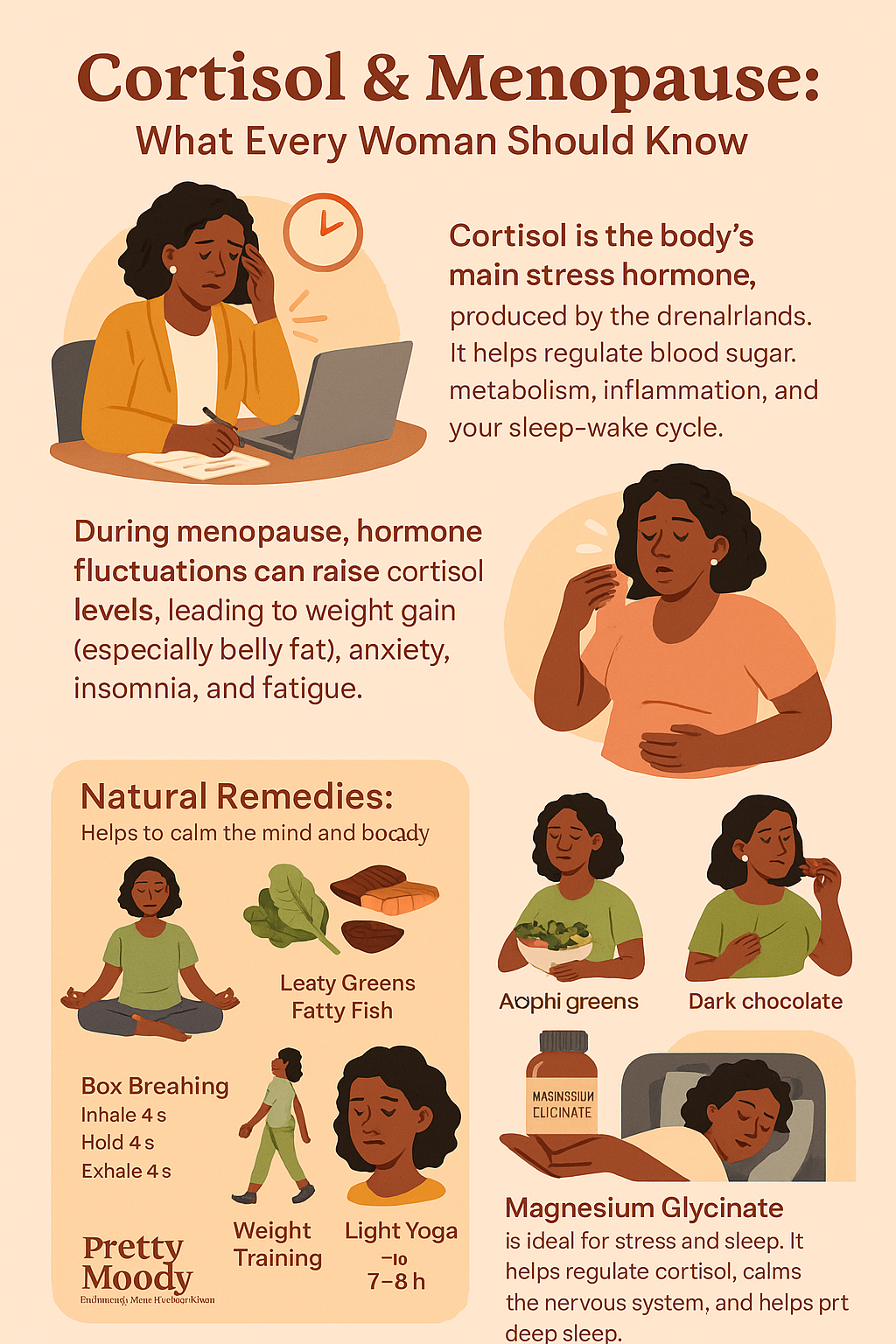THAT STUBBORN BELLY FAT AND WHAT WE CAN DO TO HELP!
Title: Sis, Let’s Talk About Cortisol—The Hidden Culprit Behind That Stubborn Belly Fat in Menopause
Hey Pretty!
It’s me, Sherell Flagg—your menopause coach! Let’s get into something that has been messing with so many of us during this transition: cortisol.
You’ve heard the term before. Maybe from your doctor, maybe from some TikTok guru. But let’s break it all the way down—the Pretty Moody way.
💡 What Is Cortisol?
Cortisol is your body’s stress hormone, produced by your adrenal glands. It’s there to help us survive—like when we’re running from danger or under pressure. But when we’re dealing with constant stress (hello work, kids, relationships, and trying to remember why you walked into the kitchen), cortisol gets stuck in overdrive.
Now mix in menopause and whew, chile. You’ve got a hormone cocktail that’s working against your peace AND your waistline.
🌀 How Cortisol Affects Us During Menopause
During menopause, estrogen and progesterone start to dip. These hormones usually help keep cortisol in check. So when they drop, cortisol rises—and with that comes:
-
Belly fat (especially around the midsection)
-
Increased cravings and emotional eating
-
Mood swings and anxiety
-
Poor sleep
-
Fatigue and burnout
Basically, cortisol is that uninvited guest who came to your hormonal party and won’t leave.
🌿 What You Can Do to Help
Let’s talk solutions, not just problems. We’re not about suffering in silence over here—we’re about reclaiming our balance naturally and intentionally.
✨ Supplements to Support You
Certain adaptogens and minerals can help your body better respond to stress:
-
Ashwagandha: Helps reduce cortisol and anxiety.
-
Rhodiola: Boosts energy and helps your body handle physical and emotional stress.
-
Holy Basil: Supports adrenal function and calms the mind.
✨ Magnesium—The Menopause Queen
If you take nothing else from this blog, hear me on this:
Magnesium is your friend.
It’s involved in over 300 processes in the body and is a game-changer during menopause.
Here’s what it does:
-
Relaxes muscles and the nervous system
-
Promotes better sleep
-
Balances blood sugar
-
Reduces cortisol and helps you feel grounded
Best types of magnesium for menopause:
-
Magnesium Glycinate: Calming and perfect for anxiety and sleep.
-
Magnesium Citrate: Helps with digestion and mild constipation.
-
Magnesium Threonate: Supports brain function and mental clarity.
🥑 Eat to Beat Cortisol
Your body is listening to what you feed it. Give it foods that help you feel better, not just look better.
-
Leafy greens (rich in magnesium)
-
Avocados (healthy fats and fiber)
-
Berries (antioxidants + anti-inflammatory)
-
Fatty fish (omega-3s to fight inflammation)
-
Nuts and seeds (protein + magnesium)
Oh, and cut back on caffeine and sugar if you can—those two are cortisol’s hype crew.
🧘🏽♀️ Move & Breathe
We’re not talking bootcamp. We’re talking intentional movement that helps reset your nervous system.
Gentle Exercise:
-
Walking
-
Yoga
-
Pilates
-
Dance (yes, twerking counts)
These help regulate blood sugar, lower cortisol, and reduce belly fat over time.
Breathing Techniques:
Try this daily:
-
Box Breathing: Inhale for 4, hold for 4, exhale for 4, hold for 4. Repeat.
-
4-7-8 Breathing: Inhale for 4, hold for 7, exhale slowly for 8.
Breath tells your body, “We’re safe. We’re okay. Chill out.”
Final Words From Me to You
Sis, cortisol is real—but so is your power. You don’t have to accept weight gain, mood swings, and fatigue as your new normal. You just need the right support, information, and a little Pretty Moody magic.
I’m walking this journey too, and I promise you—you are not alone.
Let’s take back our energy, one breath, one herb, and one magnesium capsule at a time.
With love & blessings,
Sherell Flagg
Founder, Pretty Moody & the Pretty Moody Foundation
Hot AF Podcast | Menopause Advocate & Coach | Your Hormonal Hype Woman


